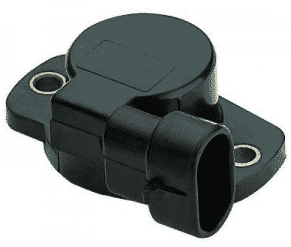Faulty Throttle Position Sensors can ruin your day!

The throttle position sensor (TPS) is a small plastic device located in the throttle body of your vehicle. It may be small, but it is an integral part of the intake system. The throttle position sensor monitors the action of the accelerator pedal and relays the information the vehicle ECU. The computer will then use this data to correctly adjust the air/fuel ratio depending on how hard you press the gas pedal.
From this information alone, it is easy to understand why a healthy TPS is important. First, it helps in maintaining a smooth idling speed. Idling problems can be caused by a wide variety of issues, such as a dirty throttle body or improper engine timing. Next, it helps your car accelerate smoothly whether from a standstill or when you’re moving at a constant speed. The throttle position sensor is also utilized by the automatic transmission CPU in order to shift the gears in accordance to the position of the gas pedal.
The Warning Signs of a Faulty Throttle Position Sensor
Here are some of the most common warning signs of a faulty TPS:
- Rough idling or idling surge. If you have a bad TPS, the engine CPU will have a hard time in setting the base ignition timing of the engine, since the TPS will send intermittent signals to the CPU. On cars with adjustable TPS, if you adjust it the wrong way then your car will have idling issues.
- Engine stalling. This can occur without warning, and even without the presence of a check engine light. Like previously mentioned, a misadjusted TPS may result in a stalled engine, or difficulty in starting the engine.
- Hesitation, sag or jerky acceleration. If your car has a faulty TPS, you can expect a slight hesitation from the time you press on the pedal to the time the car will actually move. You may also experience uneven acceleration, or a jerky movement from the engine when you press on the gas pedal.
- Sudden or erratic burst of speed when driving the car. If you notice that your car will suddenly speed up even without adding pressure on the gas pedal, then a faulty throttle position sensor is usually the culprit. This is a potentially dangerous situation, and is usually accompanied by an illuminated check engine light in the console.
- Difficulty changing gears. As we previously mentioned before, the electrical readings from the TPS is also used by the CPU of the automatic transmission. If the TPS is constantly providing false information, the A/T will have trouble switching gears, depending on the speed of the vehicle and the actual throttle input of the driver. This might also cause severe damage to your automatic transmission, which is bad news if you’re trying to save money.
- Bad fuel economy. A faulty TPS will significantly affect the MPG readings of your vehicle.
Is it Possible to Repair a Faulty Throttle Position Sensor?
Yes, if you know what you’re doing. But considering the size and complexity of the TPS, you would be better off if you just replace it at the first sign of a fault. If the check engine light is illuminated, you should use a vehicle scanning tool like the Autel MaxiScan MS300 or the ScanTool 427201 OBDLink LX to properly determine the error code.
Make sure that you order the same part number when replacing the TPS. Modern cars with fly-by-wire systems use a different kind of TPS which use non-contact type elements in the form of magnets and a Hall Effect sensor. These types of sensors are designed to last longer and are less prone to wear and tear, but they still need to be replaced when the above symptoms are present.
If you drive an older car, you should be careful in removing/replacing the TPS. You need to understand that in order for the TPS to work properly, it needs to be adjusted perfectly, as a slight maladjustment will result in rough idling or it will turn on the check engine light in your vehicle. If that is the case, you should refer to the service manual of your vehicle in order to determine the proper way to adjust the position of the TPS.
